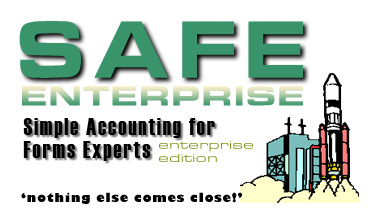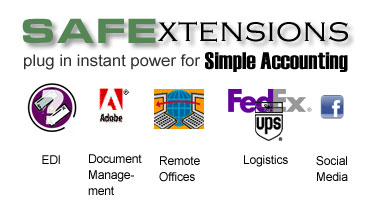It is common in the forms business to use the terms Purchase Order, Sales Order and Release in several ways to mean several different phases in the cycle of selling things to customers. Many new Simple Accounting customers will use the term order to refer to several separate business processes:
- A quote from one or more vendors on possible pricing and delivery
- A quote for your customer
- An actual Purchase Order, instructing the vendor to produce and ship the job.
- A customer bill when the order has shipped from the plant (i.e. an Invoice).
In SAFE we have a single type of transaction, called a Sales Order which records and processes anything you sell or ship to a customer. Now that covers a lot of ground, which is why were going to spend a certain amount of time on this. By the way, strangely enough, you work with Sales Orders in the Sales Order Browse (represented by the little cash register icon).
A sales order consists of the following main attributes:
- It consists of a single customer bill to (Customer ID).
- It contains a single customer P.O. (although several sales orders may use the same customer P.O.)
- It consists of a single Order ID (your Job number.)
- It will be credited to a single salesperson (or combination of salespeople in the case of splits) for sake of commissions.
- A sales order also contains at least one, but can contain an unlimited number of line items. A line item is a Product or Service you are selling or shipping (releasing) to your customer.
- Each line may be linked to a separate Vendor Purchase Order and Vendor Invoice (for capturing costs) and price.
- Furthermore, each line item may itself contain an unlimited number of Shipping Addresses, each with their own sales tax and freight calculations.
Example #1
Here is an example. Imagine your salesperson, Jim Hamilton, is in front of your customer and she wishes to place an order for checks, envelopes to mail out the checks, plus Jim also determines that they need more Inter-Company Memos which are customer-owned but stored at the manufacturer. In SAFE all three items can be fulfilled on a single sales order which Jim dubs JH100199.
Sales Order ID JH100199, Transaction #665
Customer ID: JOHNB (John B. Smith Company)
Customer PO # 123456
Sales Order ID #330678 (Your Job #)
Employee ID: JIMH (Salesperson Jim Hamilton)
Employee ID #2: SUEM (CSR Sue Munson)
Line Item #1 #10 Windowed Envelope
P.O. #55678
Wisco Invoice #34567
a. Ship 10.0M to 123 Main Street via UPS
$12.00 Freight
$26.78 Washington State Sales Tax
b. Ship 5.0M Delivered to 123 Main Street, via UPS
$12.00 Freight
$14.15 Michigan State Sales Tax
Line Item #2 A/P Continuous 2 Part Check
P.O. #55679
Flesh Company Invoice #987654
a. Ship 10.0M to 123 Main Street via Roadway
$12.00 Freight
$26.78 Washington State Sales Tax
b. Ship 5.0M Delivered to 123 Main Street, via Best Way
$12.00 Freight
$14.15 Michigan State Sales Tax
Line Item #3 Inter-Company Memos
Customer Owned
a. Release 5.0M from Datatel Warehouse to 123 Main Street via UPS
$18.00 Freight
Whoa! you say in disbelief. “Lines one and two are to different vendors! And line three isnt even an order—its a release. How can they be combined together?” They can be because SAFE knows what you want to do with each Product as its created. SAFE knows, for example, that the Inter-Company Memos are customer-owned, so when you ship them to your customer it automatically releases them from Datatels warehouse. And it knows how to print separate Purchase Orders for the envelope and the checks while keeping track of them both as part of the same Sales Order. Get it?
So a Sales Order handles all the details of all transactions which relate to selling, releasing, or shipping anything to your customers in any combination. It doesn’t matter what it is that you are billing your for: (stock items, office products, custom printing, services, freight, art, etc.).
…And it doesnt matter where you are getting it from (multiple vendors, one of your own warehouses, etc.)
…And it doesnt matter how you are getting it
…And it doesnt matter why you are selling or shipping it (transfer from one bank branch to another, release to a customer from vendor storage, etc.)
All these details are taken care of from the same screen, simply by entering different information into the sales order.
Technical Definition: What Is A Sales Order?
A sales order consists of information, stored in the Sales Order Browse, describing a sale of one or more products or services to your customer. A sales order starts with a customer ID (indicating who is buying), an Order ID (indicating this transaction throughout Simple Accounting), an Employee ID (indicating the salespeople involved in the transaction), and an opening date.
Attached to this information are one or more lLine Items. Each line item refers to a Product; the good or service you are selling to your customer. A sales order may contain as many line items as you like.
Each line item refers to a Product ID you have set up. Product IDs are set up in the Products/Services browse. A Product ID may be a custom print job with a spec, a stock item, or a service you provide. You may use a Product ID for orders to all customers (in the case of inventoried or generic items), or restrict them for use by only one customer (in the case of managed forms).
Each Line Item Has Its Own Vendor
Each line item sold may be purchased from a different vendor. When it comes time to print purchase orders, Simple Accounting can automatically combine all line items to the same vendor onto a single PO.
So a single sales order may require several purchase orders (one for each vendor on the sales order). Each purchase order has its own purchase order number which Simple Accounting uses to track the order from the vendor.
Purchase orders are linked to their sales order, which prints on the purchase order. So you and your vendor are always referring to the same number (the Sales Order ID). The actual SAFE purchase order number is rarely referred to (and need not even print on the vendors purchase order at all!)
Vendor invoices may also be linked to a sales order so that any changes you make to the vendor invoice is reflected back to the sales order from which it originated.
You invoice the customer by simply selecting the sales order and printing the invoice form. When you invoice the customer, the items with Shipped quantities are billed and any required transactions posted to A/P and the general ledger, automatically. Items which are not shipped, remain on the sales order as back ordered.
In Simple Accounting sales orders and purchase orders are considered separate business functions, but Simple Accounting recognizes the intimate link between the two in the forms business and so lets you automatically generate the necessary purchase orders from within the sales order.
We can summarize this by saying that in SAFE you enter quotes and sales orders in Sales Orders. And once you have entered the sales order you can also generate any needed purchase orders from within the sales order window.
In fact, unless your business has an inventory of stock products which you re-sell, you may never even have to use the Vendor Purchase Orders Browse!
Each Line Can Ship To Multiple Locations
A form may need to ship to several locations, so when you can specify as many Shipping Addresses as you need to. And you can select a different sales tax rate for each shipping address (site). And within each site, you can also specify which people (contacts) at that location are to receive product.
Some Examples Using Simple Accounting
Here are the most common scenarios to help you get started.
 Starting The Sales Process With A Vendor RFQ
Starting The Sales Process With A Vendor RFQ
A customer expresses interest in a form and you need to get quotes from one or more vendors before quoting the customer. To do this in Simple Accounting you would do the following:
1. Enter a Vendor Request for Quote. This enters information about:
- The customer. If this is a first time customer, you can enter itdrop-down-list as you enter the RFQ.
- The product you are quoting. Again, if this is a new item, you can enter it on the fly with the RFQ. If the item required a printer specification, you can enter that also.
- The quantities you wish to be quoted on, plus the turn-around time for each quantity.
- One or more vendors you wish to receive quotes from. You can also enter these on the fly.
2. While still in the RFQ Editing Window, print the RFQ. This prints the same RFQ for each vendor you entered. If you are faxing from your desk you will be glad to know that (as you would expect) separate faxes are generated automatically with each vendors proper fax number and cover page information. After printing, the RFQ is saved and you are returned to the RFQs browse.
3. When you receive your bids from your vendors, return to the RFQ to enter their bids. Into each line item, enter the vendors cost, estimated ship date, and Ship Via for each line item on the RFQ.
4. After entering the bids, you can now press the [Convert] button at the bottom of the RFQ Editing Window to convert the RFQ to either a sales order or a sales quote. You have two options when converting the RFQ.
A. Accept one quote and convert it to a Sales Order. This creates a Vendor Purchase Order and a Sales Orders. As you accept the vendor quote, you also select which quantity to order from the plant as well as the turn-around time. Use this option if you do not need to enter a quote to the customer before ordering from the vendor. From this point onward, you would follow the steps described below for Starting The Sales Process With a Sales Order.
or
B. Create a sales quote. This creates a sales order with an Order Status of Q. The Accept Window let you select the combinations of vendors/prices/quantities and put as many as you like on your sales quote. You would then print the quote and await customer acceptance. From this point onward, you would follow the steps described below for Starting The Sales Process With a Sales Quote.
When the customer accepts, you would go to Sales Orders and change the ORDER STATUS field to O. When you save the order, you will then need to create a new Vendor Purchase Order for this item.
5. Print the Vendor Purchase Order. No matter which method you chose to get here, you now have a live sales order and a Purchase Order waiting to print.
6. Receive the Vendor Acknowledgement. At this point you return to Sales Orders to either print a customer acknowledgement, or print an invoice to the customer. Once you invoice the customer, all files are immediately updated and the Purchase Order automatically marked as completed.
 Starting The Sales Process With a Sales Quote
Starting The Sales Process With a Sales Quote
A customer expresses interest in a form and desires a proposal, but you do not need an RFQ to begin. Do the following:
1. Enter a Sales Order. Make certain the ORDER STATUS field is set to Q. Enter one line item for each quantity to quote. You may mix products on the same quote. This enters information about:
- The customer. If this is a first time customer, you can enter itdrop-down-list as you enter the RFQ.
- The product you are quoting. Again, if this is a new item, you can enter it on the fly with the RFQ. If the item required a printer specification, you can enter that also.
- The quantities you wish to quote on, plus the turn-around time for each quantity.
- The vendor and costs involved in each line item.
2. Print the Quote by pressing the [Print] button. Then await customer acceptance.
3. When the customer accepts, go back to Sales Orders and do the following:
a. In the header, change the ORDER STATUS field to O.
b. Delete the line items which were not accepted, leaving only the line items which were accepted. When you save the order, you will be prompted to generate a Vendor Purchase Order for this item.
c. Tag the line items you wish to print Purchase Orders for. (Or press the [Tag All] button to tag them all with one keystroke.)
d. Print the Vendor Purchase Orders by pressing the [Print P.O.s] button. This saves the order.
4. When you receive acknowledgement from your vendor, return to the sales order and edit each sales order line item with the vendors invoice, invoice date, and any overruns, art costs, freight costs, etc. Then save the order.
5. Then youll need to either:
a. Print a customer acknowledgement, or
b. Print an invoice.
Do either by pressing the [Print] button at the bottom of the sales order browse.
Once you invoice the customer, all files are immediately updated; the Purchase Order marked as completed.
 Starting The Sales Process With a Sales Order
Starting The Sales Process With a Sales Order
A customer places an order for a form. There is no need for an RFQ or a sales quote. So youre starting with a live order. All you need to do is enter the order, order the product and bill the customer when it ships. To do this in Simple Accounting, follow these steps:
1. Enter a Sales Order. A sales order consists of two parts: The header and one or more line items:
In the header, make certain the ORDER STATUS field is set to O. If this is a first time customer, you can enter itdrop-down-list as you enter the order.
You’ll also need to enter at least one line item. You will enter one line item for each product(s) you are selling. Again, if this is a new item, you can enter it on the fly from the Products browse. (If the item required a printer specification, you could enter that also.) The line items also contain the quantities, prices and costs, and vendor of each product on the sales order.
2. While you are still in the Order Editing Window, Tag the line items you wish to print Purchase Orders for. (Or press the [Tag All] button to tag them all with one keystroke.)
3. Print the Vendor Purchase Orders by pressing the [Print P.O.s] button. This saves the order.
4. When you receive acknowledgement from your vendor, return to the sales order and edit each sales order line item with the vendors invoice, invoice date, and any overruns, art costs, freight costs, etc. Then save the order.
5. Then you’ll need to either:
a. Print a customer acknowledgement, or
b. Print an invoice .
Do either by pressing the [Print] button at the bottom of the sales order browse.
Once you invoice the customer, all files are immediately updated; the Purchase Order marked as completed.
 Repeat Orders
Repeat Orders
A customer needs to reorder a custom form that is already on file. Very easy. There are four steps in this process.
1. Locate the previous order and Clone it. There are three easy ways to do this.
 |
Locate the previous sales order. Go to the Sales Order and look up the order, by Order ID, Customer Name, Invoice #. Press [View] to look at the order, then [Clone] to make a new version of it. |
 |
Locate the customer and the product they wish to order from the Sales History Line Item browse. Press [View] to look at the order, then [Clone] to make a new version of it. |
 |
To create a new RFQ for an item, you can also locate the product to be reordered from the Products browse. Then move to the Catalog tab and press the [RFQ] button. |
Pressing the [Clone] button creates a new order with all the same information from the previous order. Note that the ORDER TYPE field defaults to Exact Repeat on the new order. Fill out any necessary changes.
2. While still in the order, tag the line items on the sales order, the press the [Print POs] button to generate purchase orders or RFQs for the items on the sales order.
3. When the product comes in, go back to the sales order and edit the line items. At this time, enter the vendor invoice number and invoice date and make any final tweaks to the cost, art cost, and freight fields. Then save the order.
4. Press the [Print] button at the bottom of the sales order browse to print the customer invoice. As you print the invoice, a new bill is automatically entered for you into the Vendor Invoice browse.



